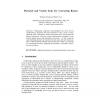Free Online Productivity Tools
i2Speak
i2Symbol
i2OCR
iTex2Img
iWeb2Print
iWeb2Shot
i2Type
iPdf2Split
iPdf2Merge
i2Bopomofo
i2Arabic
i2Style
i2Image
i2PDF
iLatex2Rtf
Sci2ools
COSIT
1999
Springer
1999
Springer
Pictorial and Verbal Tools for Conveying Routes
Traditionally, depictions and descriptions have been seen as complementary; depictions have been preferred to convey iconic or metaphorically iconic information whereas descriptions have been preferred for abstract information. Both are external representations designed to complement human memory and information processing. We have found the same underlying structure and semantics for route maps and route directions. Here we find that limited schematic map and direction toolkits are sufficient for constructing directions, supporting the possibility of automatic translation between them.
| Added | 04 Aug 2010 |
| Updated | 04 Aug 2010 |
| Type | Conference |
| Year | 1999 |
| Where | COSIT |
| Authors | Barbara Tversky, Paul U. Lee |
Comments (0)

